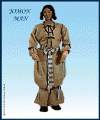
Kimonos
The Japanese kimono is not ever mentioned in the Redwall series. However, many Redwallers are also fans of Japanese animation, and so there are a lot of Redwall characters running around on the ROC with katanas (Japanese swords), shuriken (a sort of small throwing dagger that looked more like a large needle), and other Japanese weaponry.
The word kimono actually means "Japanese-style clothing," but mainly refers to a historical, traditional outfit now worn only on certain occasions. Like European gowns, kimono styles have changed drastically over the ages. Kimonos are worn by both men and women, and there are certain styles for children as well.
Below are examples of kimonos from throughout Japanese history. For the modern kimono, click here.
Joman Period - Pre-300 A.D.
The clothing of this period was simpler than the later ones, and made of hemp. Men and women wore the same styles of clothing, without anything to differentiate the two. Click on the thumbnail for a larger picture.
Yamato Period - 300-550 A.D.
The Chinese had settled Japan and introduced silkworm farming during this period, and so silk became frequently used in kimonos by those who could afford it. Most kimonos were white, as dyeing was not well-advanced at the time. The clothing was mostly made in two pieces, one for the torso and one for the legs. Sleeves were usually fairly tight.
Asuka Period - 550-710 A.D.
With the Asuka (pronounced ahs-kah) period came more developed methods of sewing, and so clothing became wider and longer. The difference in clothing between men and women became more marked. The rank of a person could be determined by the color of their clothing, and courtiers' clothing was divided into formal clothing, court clothing, and uniforms.
Nara Period - 710-792 A.D.
Clothing changed little between the Asuka period and the Nara period. Dyeing methods had obviously improved, as can be seen by the pictures. Clothing consisted of many pieces, though the less wealthy would have had much fewer garments. The basic upper and lower garments were used, as well as a jacket, a front skirt, and a back skirt. Pictured below are two members of royalty.
Heian Period - 792-1192 A.D.
Kimonos were many and varied during this period. The Japanese love of art, beauty, and color became expressed through their clothing, as well as through other areas. One kimono was the junihito kimono, which meant "twelve layers." Court women wore between 10 and 20 layers at a time. The color pattern of the layers symbolized seasons, directions, virtues, and elements of the earth, as well as serving the more practical purpose of keeping the wearer warm. The long-sleeved, every-day court clothes of men were called noshi. In court, warriors wore the bukan-sokutai. Ladies-in-waiting wore the unete. When hunting, the suikan was worn. Young women and children wore the kazami at court during warmer weather.
Muromachi Period - 1192-1573 A.D.
It wasn't until the Muromachi period that the Japanese actually got some sense into their heads and started wearing clothes they could actually walk in. Or at least, they were supposedly easier to move in - they don't really look it... This was because the samurai, or Japanese warriors, gained power and needed clothing to suit their active lives. Below is an example of a woman in Muromachi-period clothing.
Edo Period - 1601-1867 A.D.
As commerce and industry rapidly developed, merchants overtook the samurai in terms of power. A dye-resistant dyeing method was developed, called the yuzen dyeing technique. This technique became widely because just about any color could be used, and complex patterns such as flowers or birds could be created with it. This is when the most well-known kimono became developed. It was multicolored, very decorated with patterns, and worn in a single layer. The wide, often silk belt, called the obi, was now tied in the back - before, it had been tied in the front.
For more information:
|
|
JP Net Kimono Hypertext |